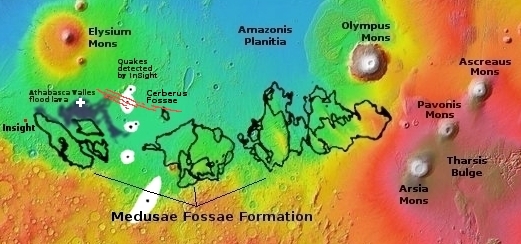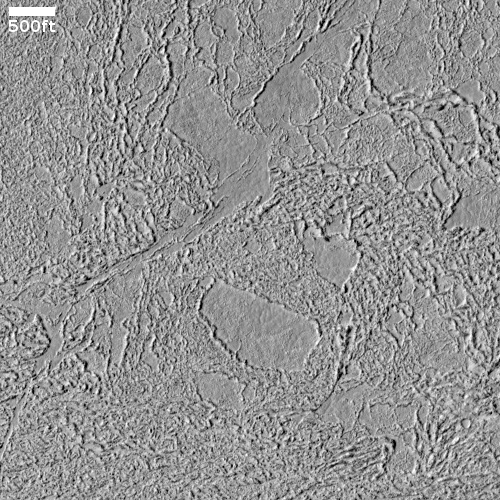Stucco on Mars!
Cool image time! The picture to the right, cropped to post here, was taken on June 8, 2021 by the high resolution camera on Mars Reconnaissance Orbiter (MRO). It shows a strangely flat plain with a complex stucco-type surface of ridges and depressions. The sunlight is coming from the west, which makes the smoother flat areas depressions.
What are we looking at? What causes this strange surface? Make sure you look at the full image, because the section I cropped out doesn’t give a true sense of the terrain’s vastness.
The MRO science team labeled the photo “volcanic terrain,” but that tells only part of the story, since this volcanic terrain is actually part of Mars’ most interesting lava plains, as the overview map below shows.

The white cross marks this photo’s location, in the middle of what scientists [pdf] have dubbed the Athabasca Valles flood lava. Athabasca, which covers an area about the size of Great Britain, is thought to be one of the youngest such flood plains on Mars, from 1 to 20 million years ago. Moreover, it is believed that the magma flooded this territory very quickly, covering this vast region in only a matter of weeks.
You would think that such a fast flow would result in a very smooth and flat frozen surface. See for example this September 2020 cool image of a nearby piece of the Athabasca flood, about 150 miles to the east. There the flood has frozen smooth as it partly engulfed and filled a crater.
Here however things are different. Though this terrain is flat and there are smooth patches, most of it resembles the exterior walls of my Arizona house, stuccoed to produce a textured look.
Why? Why the difference? Is this a feature of the lava itself? Or are we looking at later erosion processes?
On Christmas Eve 1968 three Americans became the first humans to visit another world. What they did to celebrate was unexpected and profound, and will be remembered throughout all human history. Genesis: the Story of Apollo 8, Robert Zimmerman's classic history of humanity's first journey to another world, tells that story, and it is now available as both an ebook and an audiobook, both with a foreword by Valerie Anders and a new introduction by Robert Zimmerman.
The print edition can be purchased at Amazon or from any other book seller. If you want an autographed copy the price is $60 for the hardback and $45 for the paperback, plus $8 shipping for each. Go here for purchasing details. The ebook is available everywhere for $5.99 (before discount) at amazon, or direct from my ebook publisher, ebookit. If you buy it from ebookit you don't support the big tech companies and the author gets a bigger cut much sooner.
The audiobook is also available at all these vendors, and is also free with a 30-day trial membership to Audible.
"Not simply about one mission, [Genesis] is also the history of America's quest for the moon... Zimmerman has done a masterful job of tying disparate events together into a solid account of one of America's greatest human triumphs."--San Antonio Express-News
Cool image time! The picture to the right, cropped to post here, was taken on June 8, 2021 by the high resolution camera on Mars Reconnaissance Orbiter (MRO). It shows a strangely flat plain with a complex stucco-type surface of ridges and depressions. The sunlight is coming from the west, which makes the smoother flat areas depressions.
What are we looking at? What causes this strange surface? Make sure you look at the full image, because the section I cropped out doesn’t give a true sense of the terrain’s vastness.
The MRO science team labeled the photo “volcanic terrain,” but that tells only part of the story, since this volcanic terrain is actually part of Mars’ most interesting lava plains, as the overview map below shows.

The white cross marks this photo’s location, in the middle of what scientists [pdf] have dubbed the Athabasca Valles flood lava. Athabasca, which covers an area about the size of Great Britain, is thought to be one of the youngest such flood plains on Mars, from 1 to 20 million years ago. Moreover, it is believed that the magma flooded this territory very quickly, covering this vast region in only a matter of weeks.
You would think that such a fast flow would result in a very smooth and flat frozen surface. See for example this September 2020 cool image of a nearby piece of the Athabasca flood, about 150 miles to the east. There the flood has frozen smooth as it partly engulfed and filled a crater.
Here however things are different. Though this terrain is flat and there are smooth patches, most of it resembles the exterior walls of my Arizona house, stuccoed to produce a textured look.
Why? Why the difference? Is this a feature of the lava itself? Or are we looking at later erosion processes?
On Christmas Eve 1968 three Americans became the first humans to visit another world. What they did to celebrate was unexpected and profound, and will be remembered throughout all human history. Genesis: the Story of Apollo 8, Robert Zimmerman's classic history of humanity's first journey to another world, tells that story, and it is now available as both an ebook and an audiobook, both with a foreword by Valerie Anders and a new introduction by Robert Zimmerman.
The print edition can be purchased at Amazon or from any other book seller. If you want an autographed copy the price is $60 for the hardback and $45 for the paperback, plus $8 shipping for each. Go here for purchasing details. The ebook is available everywhere for $5.99 (before discount) at amazon, or direct from my ebook publisher, ebookit. If you buy it from ebookit you don't support the big tech companies and the author gets a bigger cut much sooner.
The audiobook is also available at all these vendors, and is also free with a 30-day trial membership to Audible.
"Not simply about one mission, [Genesis] is also the history of America's quest for the moon... Zimmerman has done a masterful job of tying disparate events together into a solid account of one of America's greatest human triumphs."--San Antonio Express-News



Perhaps as the flow at the edges cooled, lava behind piled up on itself, as it had nowhere to go.
Galactus likes to spackle as a hobby.